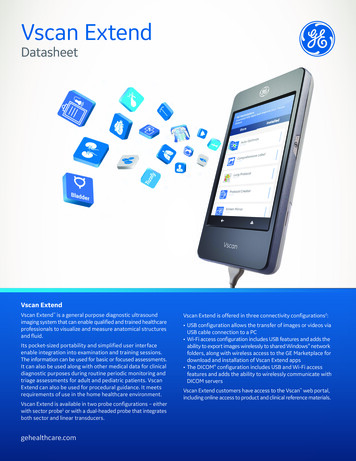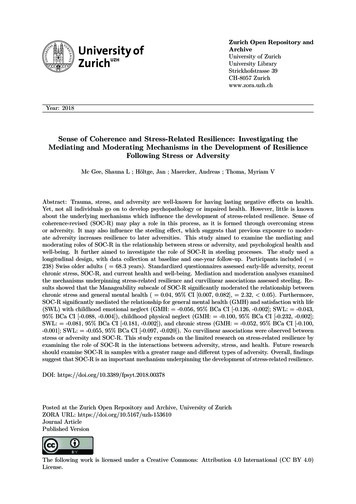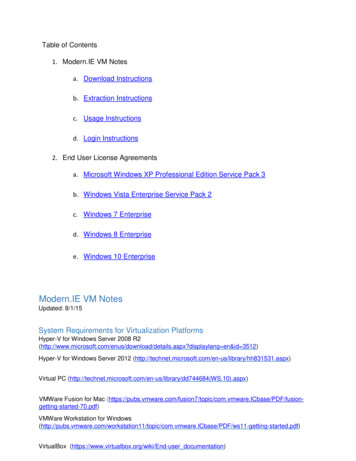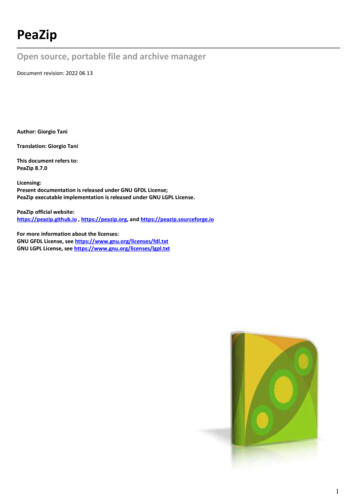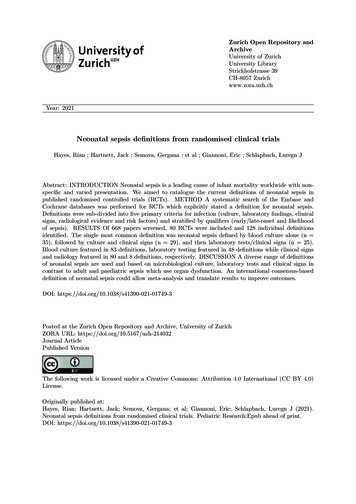
Transcription
Zurich Open Repository andArchiveUniversity of ZurichUniversity LibraryStrickhofstrasse 39CH-8057 Zurichwww.zora.uzh.chYear: 2021Neonatal sepsis definitions from randomised clinical trialsHayes, Rían ; Hartnett, Jack ; Semova, Gergana ; et al ; Giannoni, Eric ; Schlapbach, Luregn JAbstract: INTRODUCTION Neonatal sepsis is a leading cause of infant mortality worldwide with nonspecific and varied presentation. We aimed to catalogue the current definitions of neonatal sepsis inpublished randomised controlled trials (RCTs). METHOD A systematic search of the Embase andCochrane databases was performed for RCTs which explicitly stated a definition for neonatal sepsis.Definitions were sub-divided into five primary criteria for infection (culture, laboratory findings, clinicalsigns, radiological evidence and risk factors) and stratified by qualifiers (early/late-onset and likelihoodof sepsis). RESULTS Of 668 papers screened, 80 RCTs were included and 128 individual definitionsidentified. The single most common definition was neonatal sepsis defined by blood culture alone (n 35), followed by culture and clinical signs (n 29), and then laboratory tests/clinical signs (n 25).Blood culture featured in 83 definitions, laboratory testing featured in 48 definitions while clinical signsand radiology featured in 80 and 8 definitions, respectively. DISCUSSION A diverse range of definitionsof neonatal sepsis are used and based on microbiological culture, laboratory tests and clinical signs incontrast to adult and paediatric sepsis which use organ dysfunction. An international consensus-baseddefinition of neonatal sepsis could allow meta-analysis and translate results to improve outcomes.DOI: https://doi.org/10.1038/s41390-021-01749-3Posted at the Zurich Open Repository and Archive, University of ZurichZORA URL: https://doi.org/10.5167/uzh-214032Journal ArticlePublished VersionThe following work is licensed under a Creative Commons: Attribution 4.0 International (CC BY 4.0)License.Originally published at:Hayes, Rían; Hartnett, Jack; Semova, Gergana; et al; Giannoni, Eric; Schlapbach, Luregn J (2021).Neonatal sepsis definitions from randomised clinical trials. Pediatric Research:Epub ahead of print.DOI: https://doi.org/10.1038/s41390-021-01749-3
www.nature.com/prSYSTEMATIC REVIEWOPENNeonatal sepsis definitions from randomised clinical trialsRían Hayes1, Jack Hartnett1, Gergana Semova1, Cian Murray1, Katherine Murphy1, Leah Carroll1, Helena Plapp1, Louise Hession1,Jonathan O’Toole1, Danielle McCollum1, Edna Roche1, Elinor Jenkins1, David Mockler2, Tim Hurley1,3, Matthew McGovern1,3,John Allen1,3,4, Judith Meehan1,4, Frans B. Plötz5,6, Tobias Strunk7,8, Willem P. de Boode9, Richard Polin10, James L. Wynn11,12,Marina Degtyareva13, Helmut Küster14, Jan Janota15,16, Eric Giannoni17, Luregn J. Schlapbach18,19,20, Fleur M. Keij21, Irwin K. M. Reiss21, Joseph Bliss22, Joyce M. Koenig23, Mark A. Turner24, Christopher Gale25, Eleanor J. Molloy1,3,4,26,27 and On behalf of the Infection,Inflammation, Immunology and Immunisation (I4) section of the European Society for Paediatric Research (ESPR) The Author(s) 20211234567890();,:INTRODUCTION: Neonatal sepsis is a leading cause of infant mortality worldwide with non-specific and varied presentation. Weaimed to catalogue the current definitions of neonatal sepsis in published randomised controlled trials (RCTs).METHOD: A systematic search of the Embase and Cochrane databases was performed for RCTs which explicitly stated a definitionfor neonatal sepsis. Definitions were sub-divided into five primary criteria for infection (culture, laboratory findings, clinical signs,radiological evidence and risk factors) and stratified by qualifiers (early/late-onset and likelihood of sepsis).RESULTS: Of 668 papers screened, 80 RCTs were included and 128 individual definitions identified. The single most commondefinition was neonatal sepsis defined by blood culture alone (n 35), followed by culture and clinical signs (n 29), and thenlaboratory tests/clinical signs (n 25). Blood culture featured in 83 definitions, laboratory testing featured in 48 definitions whileclinical signs and radiology featured in 80 and 8 definitions, respectively.DISCUSSION: A diverse range of definitions of neonatal sepsis are used and based on microbiological culture, laboratory tests andclinical signs in contrast to adult and paediatric sepsis which use organ dysfunction. An international consensus-based definition ofneonatal sepsis could allow meta-analysis and translate results to improve outcomes.Pediatric Research; TIONAn estimated 3,000,000 newborns are affected by sepsisannually1 with mortality set to reach 375,000 in 2019 (ref. 2).Despite ongoing advances in molecular diagnostics,3 theaccurate and timely diagnosis of sepsis in neonates remainschallenging. Current conventional gold standard diagnosis ofsepsis based on microbial culture does not appear to reliablyrule-out sepsis, with reported rates of ‘culture-negative’ or‘suspected’ sepsis varying widely in the literature. While someexperts advocate to consider sepsis evaluations completed after48–72 h of negative blood cultures4,5 data available from twolarge randomised controlled trials (RCTs) in recent years (INIS6and ELFIN7) show culture-negative sepsis rates of 56% and 46%,respectively.Antibiotic overuse and resistance are increasingly common butunder-recognition of sepsis remains an issue resulting incampaigns from the World Health Organisation (WHO).8Sepsis-3 (ref. 9), the recent consensus definitions for sepsis andseptic shock in adults, primarily uses multiorgan dysfunctionrather than microbial culture in the screening and diagnosis ofsepsis. Even when microbiological tests are completed, culturepositive ‘sepsis’ is observed in only 30–40% of cases in adults.9Neonatal sepsis literature is therefore at variance with adult andpaediatric sepsis consensus and a greater emphasis on multiorgan1Discipline of Paediatrics, Trinity College Dublin, the University of Dublin & Children’s Hospital Ireland (CHI) at Tallaght, Dublin, Ireland. 2John Stearne Medical Library, TrinityCollege Dublin, St. James’ Hospital, Dublin, Ireland. 3Trinity Translational Medicine Institute, St James Hospital, Dublin, Ireland. 4Trinity Research in Childhood Centre (TRiCC),Trinity College Dublin, Dublin, Ireland. 5Department of Paediatrics, Tergooi Hospital, Blaricum, The Netherlands. 6Department of Paediatrics, Amsterdam UMC, University ofAmsterdam, Emma Children’s Hospital, Amsterdam, The Netherlands. 7Neonatal Health and Development, Telethon Kids Institute, Perth, WA, Australia. 8Neonatal Directorate,King Edward Memorial Hospital for Women, Perth, WA, Australia. 9Radboud Institute for Health Sciences, Department of Neonatology, Radboud University Medical Center, AmaliaChildren’s Hospital, Nijmegen, The Netherlands. 10Division of Neonatal-Perinatal Medicine, Department of Pediatrics, Columbia University Medical Center, New York City, NY, USA.11Department of Pediatrics, University of Florida, Gainesville, FL, USA. 12Department of Pathology, Immunology, and Laboratory Medicine, University of Florida, Gainesville, FL,USA. 13Department of Neonatology, Pirogov Russian National Research Medical University, Moscow, Russia. 14Neonatology, Clinic for Paediatric Cardiology, Intensive Care andNeonatology, University Medical Centre Göttingen, Göttingen, Germany. 15Neonatal Unit, Department of Obstetrics and Gynecology, Motol University Hospital and SecondFaculty of Medicine, Prague, Czech Republic. 16Institute of Pathological Physiology, First Faculty of Medicine, Charles University, Prague, Czech Republic. 17Clinic of Neonatology,Department Mother-Woman-Child, Lausanne University Hospital and University of Lausanne, Lausanne, Switzerland. 18Paediatric Critical Care Research Group, Child HealthResearch Centre, University of Queensland, Brisbane, Australia. 19Paediatric Intensive Care Unit, Queensland Children’s Hospital, Brisbane, Australia. 20Department of Pediatrics,Bern University Hospital, University of Bern, Bern, Switzerland. 21Department of Pediatrics, Division of Neonatology, Erasmus MC-Sophia Children’s Hospital, Rotterdam, TheNetherlands. 22Department of Pediatrics, Women & Infants Hospital of Rhode Island, Alpert Medical School of Brown University, Providence, USA. 23Division of Neonatology, SaintLouis University, Edward Doisy Research Center, St. Louis, MO, USA. 24Institute of Translational Medicine, University of Liverpool, Centre for Women’s Health Research, LiverpoolWomen’s Hospital, Liverpool, UK. 25Neonatal Medicine, School of Public Health, Faculty of Medicine, Chelsea and Westminster campus, Imperial College London, London, UK.26Paediatrics, Coombe Women’s and Infant’s University Hospital, Dublin, Ireland. 27Neonatology, CHI at Crumlin, Dublin, Ireland. email: Eleanor.molloy@tcd.ieReceived: 9 July 2021 Revised: 27 August 2021 Accepted: 31 August 2021
R. Hayes et al.2dysfunction may be merited. The neonatal Sequential OrganFailure Assessment Score (nSOFA)10 characterises neonatal organdysfunction and predicts mortality in this setting, and thus thepotential for its use in the definition of neonatal sepsis. Measuresof neonatal organ dysfunction have been developed but remaindistinct from definitions of infection or sepsis at present.Neonatal sepsis, especially in vulnerable (e.g. very low birthweight) populations, is strongly associated with increased rates ofcomplications of prematurity11,12 and adverse neurodevelopmentaloutcomes.13–18 These unfavourable outcomes emphasise the needfor rapid recognition of sepsis and initiation of antibiotic therapy.However, unnecessary empiric antibiotic prescription is associatedwith increasing long term morbidity and mortality,19–28 and currentantibiotic prescribing habits have been shown to vary widelyinternationally.29–32 These issues emphasise the need for a consensusdefinition of neonatal sepsis so that standardised outcomes data canfeed back into diagnostic and therapeutic improvement.33In this study we aimed to systematically review the definitionsof neonatal sepsis used in published RCTs. This process is intandem with a separate analysis34 which examines the use ofdefinitions of neonatal sepsis in observational and experimentalstudies from neonatal surveillance and research networks. Thegoal here is to identify commonalities and differences betweendefinitions of neonatal sepsis in order to define core themes forDelphi and consensus processes to develop a universally accepteddefinition for neonatal sepsis.METHODSSearch strategyIn May 2019, the Embase and Cochrane databases were searchedwith the algorithm (‘neonatal’ OR ‘newborn’) AND (‘sepsis’ OR‘septicaemia’). No date restrictions were imposed on results. Onlyrandomised clinical trials in the English language which explicitlystated a definition for neonatal sepsis were included. All otherpublications, including observational studies, reviews and RCTs forwhich a full text was not available, and RCTs that included nonneonatal paediatric patients were excluded.Data collection and analysisThe following data were extracted from the included studies: yearof publication, sample size, verbatim definition of sepsis, andprimary and secondary outcomes measured. After a preliminaryreview of the data, the authors characterised five primary criteriafrom which all the definitions of neonatal sepsis were composed:microbiological culture, clinical signs of infection, laboratory signsof infection, radiological signs of infection, and the presence ofrisk factors for infection. Many RCTs presented algorithmicdefinitions of neonatal sepsis, e.g. ‘Neonatal sepsis was definedas a positive microbial culture plus either laboratory signs of sepsisor clinical signs of sepsis’. To enable adequate analysis, thesealgorithms were broken down by their component primarycriteria. For instance, in the above definition that diagnosedneonatal sepsis as ‘positive culture plus clinical signs or laboratorysigns of infection’ we took this as two separate definitions ofneonatal sepsis: (1) culture plus clinical signs of infection and (2)culture plus laboratory signs of infection. For each primarycriterion, a detailed breakdown of the relevant secondary criteriawas collected. Where definitions included microbiological cultureas a criterion, the collected secondary criteria were: culture site(s),the number of samples required to be positive, pathogenscultured for, the time the sample was taken, and the incubationtime. For laboratory signs, clinical signs, radiological signs, and riskfactors for infection, the frequency of individual signs wasrecorded. Where definitions specified a required number ofpositive signs in a specific category, these figures were recorded.Many definitions of neonatal sepsis included qualifiers (e.g. early/late, suspected/proven, coagulase-negative staphylococci (CoNS)and additional criteria for severe sepsis/septic shock). Thesequalifiers were recorded and a sub-analysis of the criteria theyused was performed.RESULTSSearch resultsA total of 668 papers were identified by the search, of which 344were excluded based on screening of the title and abstract; 80 ofthe remaining 324 studies met the inclusion criteria for the reviewas RCTs and were included in the analysis of the full text. Theselection of studies was undertaken in accordance with thePRISMA (Preferred Reporting Items for Systematic Reviews andMeta-Analyses) guidelines (Fig. 1).Study characteristicsA total of 80 randomised clinical trials4,5,8,35–122 were included inthe review from 1986 to 2019 yielding a total of 128 individualdefinitions of neonatal sepsis when broken down by componentprimary criteria (Table 1): microbiological culture, clinical signs ofinfection, laboratory signs of infection, radiological signs ofinfection, and the presence of risk factors for infection. Thetabulated raw dataset is available in Appendix 1. The total samplesize comprised by the trials was 40,992 neonates, the mediansample size was 150, and the mean sample size was 512. The mostrepresented primary criterion was microbiological culture, whichwas a component of 83 separate definitions. The frequency ofother primary criteria appeared as follows: clinical signs ofinfection (n 81), biochemical/haematological signs of infection(n 48), radiological signs of infection (n 8), risk factors forinfection (n 2). None of the included definitions were consensusor guideline definitions.Primary outcomes(1) Microbiological cultureMicrobiological culture was a component of 83 out of 128definitions of neonatal sepsis (Table 1). These 83 definitionswere from 68 different papers.Culture source: Of the 83 culture-related definitions,74 specified a site the culture sample was taken from, while9 mentioned ‘culture’ without specifying a sample site. Ofthe 74 that specified culture sites, the frequency of each sitementioned is outlined in Table 2. Three definitions requiredtwo positive cultures to diagnose sepsis.Pathogen: 12 definitions specified a pathogen sought bymicrobiological culture. Five specified bacteria, 4 specifiedfungi, and the remainder mentioned ‘known virulentpathogens’, or ‘not Staphylococcus epidermidis’.Incubation time: Only one study mentioned incubationtime, which outlined that a microorganism was regarded asinfectious if it grew within 48 h incubation.(2) Clinical signs of infectionClinical signs were a component of 81 definitions. Sevendefined sepsis based on signs alone and 74 defined sepsisbased on signs in conjunction with other primary criteria,culture being the most common. These 81 definitionsrepresent 35 RCTs that gave only 1 definition of sepsis thatincluded clinical signs, and a further 18 papers which hadmultiple definitions that included clinical signs. Ten of these18 papers gave a definition based on culture and clinicalsigns, and another definition based on laboratory criteriaand clinical signs. Several other papers which includedclinical signs in their definitions also gave multiple definitions that distinguished between possible and probablesepsis. Out of 81 definitions of sepsis to include clinicalsigns, 41 specified the signs that were looked for (eitherPediatric Research
R. Hayes et al.Identification3Abstracts identified throughdatabase search(n 712)Additional abstracts identifiedthrough other sources(n 18)Abstracts after duplications were removed(n 668)Abstracts excluded basedon screening of title(n 344)ScreeningAbstracts screened(n 668)Full-text articles excludedas:Incorrect patientpopulationIncorrect settingsFull-text articles assessedfor eligibility(n 324)Included(n 244)Fig. 1Studies included in the review(n 80)PRISMA flow diagram of studies included in the systematic review of definitions of neonatal sepsis in randomised controlled trials.Table 1.Table 2.Definitions of neonatal sepsis by primary criteria.Definitions mentioning specific culture source.Combination of primary criteriaNCulture sourceNCulture alone35Blood71Culture signs29Cerebrospinal fluid29Signs laboratory25Urine10Culture signs laboratory12Skin/surface4Signs alone7Pus [unspecified]3Culture labs6Tracheal aspirate2Signs radiology6Synovial fluid1Laboratory alone4Peritoneal fluid1Signs risk factors2Intravascular catheter1Culture laboratory radiology1Any sterile site1Radiology alone1examples given, or a prescriptive list), the remaining 40definitions mentioned signs without specifying what signswere looked for 20 definitions explicitly stated how manysigns had to be present, with a breakdown as follows: 1 sign(n 8), 2 signs (n 11), and 3 signs (n 1). To categorisethe wide variety of clinical signs mentioned, signs weregrouped by system, except for ‘requirement for antibiotics’,which was grouped alone.Antibiotic requirement: Seven definitions mentioned a‘requirement for antibiotics’ as a sign of neonatal sepsis. Thedate range for these seven definitions is 2000–2018. Six of theseven definitions mention a requirement for a 5-day course ofantibiotics, intention to treat for 5 days, or neonatal deathbefore completion of a 5-day antibiotic course.Pediatric ResearchOverview of clinical signs: The categories of clinical signsappeared in the following order of frequency: systemic (n 32), respiratory (n 29), cardiovascular (n 28), gastrointestinal signs (n 12), neurological (n 12), and miscellaneous(n 8). The frequency of individual signs within each categoryis outlined in Table 3.Systemic signs: The 32 definitions specifying constitutionalsigns represent information from 22 separate papers. Theconstitutional signs were further stratified into five maincategories: lethargy, temperature, feeding, cry, and colour(Table 3).Respiratory signs: The 29 definitions specifying respiratorysigns represent information from 20 separate papers. Thelisted respiratory signs were further stratified into three maincategories: hypoxaemic signs, signs of distress, and requirement for support (Table 3).
R. Hayes et al.1Staff concern3Organ Sclerema14Jaundice/icterusIncreased gastric aspirate11Cold extremities21Rate instability10Tachypnoea12Respiratory distress12BP 2 SD below normal22Apnoea1ShockCardiovascular collapse12Rate 2 SD above normal32CyanosisGagging313Pallor4Grunting353CRT 3 sBulging l O25Inotropic/fluid y42Reduced reflexesHypotonia7Tachycardia6Poor perfusion10TachypnoeaVentilatory support179Hypotension12Respiratory distress27622Unexplained bleeding5Vomiting6SeizureHaemodynamic instability22Apnoea277SymptomDisseminated haemorrhage11NSymptomAbdominal distension7NSymptomSymptomNSymptomNNAltered cularRespiratoryColourPoor cryExcessive cryingPoor cose intoleranceFeeding intoleranceTemperature instabilityLethargySymptomSigns and symptoms present and frequency in the RCT definitions reviewed.Cardiovascular signs: The 28 definitions specifying cardiovascular signs represents information from 19 separatepapers. The listed cardiovascular signs were divided intothree broad categories: heart rate, blood pressure, andindicators of perfusion (Table 3).Neurological signs: The 12 definitions specifying neurological signs represent information from 10 individual papers. Atotal of five neurological signs were mentioned (Table 3).Gastrointestinal signs: A total of six gastrointestinal signswere mentioned (Table 3).Miscellaneous signs: The eight definitions that specifiedmiscellaneous signs represent information from six individualpapers. A total of nine miscellaneous signs were mentioned(Table 3).(3) Laboratory (microbiological/haematological/biochemical) signsof infectionHaematological/biochemical signs of infection were acomponent of 48 definitions of neonatal sepsis, 4 of whichdefined sepsis based on laboratory criteria alone. Theremaining 44 defined sepsis based on laboratory criteria inconjunction with other primary criteria (Table 1). The 48laboratory-related definitions of sepsis came from 41 separatepapers. Of the seven papers that provided two definitions, sixpapers included two definitions in order to distinguish betweendefinite sepsis and probable sepsis. Of these six papers, threedefined probable sepsis as laboratory criteria with clinical signsand definite sepsis as culture with laboratory criteria andclinical signs.Although there were 48 laboratory-related definitions ofsepsis, only 40 specified the laboratory tests required to makethe diagnosis, while the remaining 8 mentioned laboratoryparameters, without specifying what tests were necessary.There was a wide variation in the number of laboratoryparameters included in each definition and of the 40 definitionsthat specified laboratory tests to be positive, 21 required atleast one parameter to be abnormal, 18 requires at least 2parameters to be abnormal, and 1 required at least 3 laboratoryparameters to be abnormal. A total of 20 individual laboratorytests were mentioned by the 48 definitions of neonatal sepsisthat included laboratory criteria as a primary criterion. These 20individual parameters were grouped into five categories: bloodcount, serum inflammatory markers, metabolic markers,histopathological findings, and markers of pathogenaemia(Table 4).(4) Radiological signs of infectionThere were eight definitions of neonatal sepsis that includedradiological signs of infection and only seven specified whichradiological signs were sought. All seven definitions thatspecified signs specified chest X-ray/evidence of pneumoniaas the only relevant radiological exam.(5) Risk factors for infectionThere were two definitions of neonatal sepsis that included riskfactors for infection as a primary diagnostic criterion. The riskfactors mentioned are as follows: amnionitis (n 2), prematurerupture of membranes (n 2), foul-smelling amniotic fluid (n 1),prolonged rupture of membranes 24 h (n 1), maternal fever(n 1), maternal urinary tract infection (n 1).QualifiersConstitutionalTable 3.8MiscellaneousN41. Early- versus late-onset neonatal sepsisNo definition of neonatal sepsis specified the timeframefor neonatal sepsis as other than birth to 28 days of life. Twostudies provided definitions of both early- and late-onsetsepsis. A further 11 studies provided definitions of eitherearly or late-onset sepsis. Of the seven studies that definedPediatric Research
R. Hayes et al.5the criteria for sepsis plus objective evidence of organdysfunction.Table 4.Frequency of laboratory signs in the RCT definitionsreviewed.Laboratory signsNC-reactive protein30Not specified9 5 mg/L1 9 mg/L1 10 mg/L13 12 mg/L1 20 mg/L4 60 mg/L1White cell count (WCC)16I:T ratio15Neutrophil count13Platelet count10Micro-ESR8Band cell count7Full blood count (FBC)3IL-63Glucose3Toxic granules in peripheral smear2Bacterial gic diagnosis of pneumonia1Cerebrospinal WCC1Viral polymerase chain reaction (PCR)1CSF Gram stain1early-onset sepsis, one study defined early onset as arising 48 h of life, five studies as 72 h, and one study as 5 daysof life. Of the eight studies that defined late-onset sepsis, alleight defined late-onset sepsis as arising 72 h of life.2. Definite/probable/possible sepsisThere were 21 studies that provided definitions thatdiscriminated between degrees of certainty of the diagnosisof sepsis. Of utmost certainty were ‘definite sepsis’ or‘culture-proven sepsis’, next was ‘probable sepsis’ or ‘clinicalsepsis’, followed by ‘possible sepsis’ as defined by somestudies.3. Stringency for coagulase-negative Staphylococci (CoNS)Six papers included criteria relating to CONS. Of these,two specified that Staph. epidermidis was disregarded ifcultured, and the other four papers (three mention CONS,one mentions Staph. epi.) specified additional criteriarequired to make the diagnosis if the culture yieldedCONS/Staph. epi. Of these additional criteria, two papersrequired concomitant abnormalities of the white blood cellcount or CRP, one paper required positive cultures from twoseparate sites (usually drawn simultaneously), and onerequired culture to be positive within 48 h.4. Septic shock/severe sepsisTwo papers specified additional criteria defining either septicshock or severe sepsis. The paper defining septic shock specified itas meeting the criteria for sepsis, plus blood pressure below thefifth centile for age requiring fluid resuscitation or inotropicsupport. The paper defining severe sepsis specified it as meetingPediatric ResearchDISCUSSIONThere is considerable heterogeneity in the definitions of neonatalsepsis, both in the combinations of primary criteria used to definesepsis and in the specific secondary criteria in each category. Thisis huge problem for neonatology resulting in studies with mostdefinitions not validated, sensitive or specific and using subjectivecriteria so not comparable or generalisable. Most notably, therewas a reliance on microbiological culture for definitive diagnosisof sepsis in 85% of studies. This suggests that most of thesedefinitions actually aim to describe ‘bacteraemia’ rather than‘sepsis’. This is at variance with the adult Sepsis-3 guidelines9,34and in contrast with the recent definitions of adult and paediatricsepsis which involve an ‘inflammatory host responses with endorgan impairment’ independent of microbial detection. In additon,clinical signs of neonatal sepsis and infection are notoriouslyunreliable for diagnosis and can only trigger evaluation and maynot be part of an actual definition as they are not specific forsepsis in neonates.Most definitions using microbiological culture as an essentialcomponent for the diagnosis of sepsis vary in the exactrequisites for a positive culture. Most papers specified a culturesite and of those that did, most specified blood as the only sitewhile a minority included other possible sites (e.g. CSF). Of the83 definitions that included culture as a criterion, only 12outlined what pathogens were assumed to be pathogenicwhich is significant in the context of CONS and the possibility ofculture contamination versus nosocomial infection. Commensals represent a diagnostic quandary for neonatal sepsis,and approaches to CoNS detected in culture varied widely. Nopaper mentioned decisions in cases of a polymicrobialculture.115Most definitions included clinical signs as a component of thedefinition of sepsis; however, papers varied in the precisedefinitions of certain signs and the overall list of signs. Certainsigns predominate in frequency (Table 3) such as systemic signs,including lethargy, feeding intolerance and temperature instability, and cardiorespiratory signs including hypotension andrespiratory distress. Two of the most frequent signs listed—hypotension and respiratory distress—as well as the platelet countare parameters of organ failure measured in the SOFA score in theSepsis-3 guidelines9 and are identical to the three used for nSOFAscore.116Severe sepsis is now widely regarded to be an obsoletecharacterisation of the syndrome; however, it is notable that thestudy that defined severe sepsis characterised it as the presence oforgan dysfunction, which is the key feature of the Sepsis-3definition of sepsis in adults. Septic shock is a useful clinicaldistinction in adults and neonates, but one definition specificallylabels septic shock and other definitions include instead low bloodpressure in the definition of sepsis.9A wide range of laboratory investigations appeared in theresults, 36 definitions mentioned abnormalities of the white cellcount—or related measures like the neutrophil count, immatureneutrophil count, and immature:total neutrophil ratio andinflammation as marked by CRP or ESR. While radiological signsof infection were classed as a primary criterion, this in effectmeant signs of pneumonia on chest X-ray, given that this was theonly radiological investigation cited by any of the studies. Riskfactors for infection were cited by several studies, which includeda comprehensive range of risk factors such as chorioamnionitis,prolonged rupture of membranes, or foul-smelling amniotic fluid.There was variability in the timeframes defined for early-onsetneonatal sepsis ( 2, 3, 5 days) with better agreement on thedefinition of late-onset sepsis.
R. Hayes et al.6Definitions of neonatal sepsis used in randomised clinical trialsdemonstrate considerable variability which means that comparison of studies and outcomes is very challenging.117 The majorneonatal organisations such as National Institute of Child Healthand Human Development (NICHD) Neonatal Research Network,Centers for Disease Control and Prevention (CDC), Nosocomialinfection surveillance system for preterm infants on neonatologydepartments (NEO-KISS), Vermont Oxford Network, and theCanadian Neonatal Network also differ considerably in definingearly and late-onset sepsis, the requirement for antibiotic use or
Louis University, Edward Doisy Research Center, St. Louis, MO, USA. 24Institute of Translational Medicine, University of Liverpool, Centre for Women's Health Research, Liverpool Women's Hospital, Liverpool, UK. 25Neonatal Medicine, School of Public Health, Faculty of Medicine, Chelsea and Westminster campus, Imperial College London, London, UK.

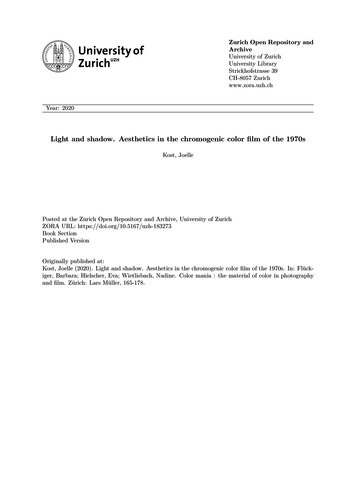
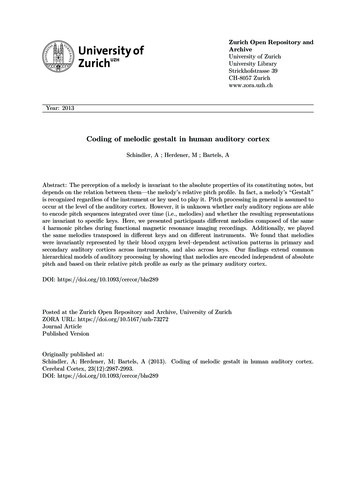
![March 3rd, 2017 [Manage Archive in Microsoft Outlook 2016]](/img/34/archive-outlook-2016.jpg)
